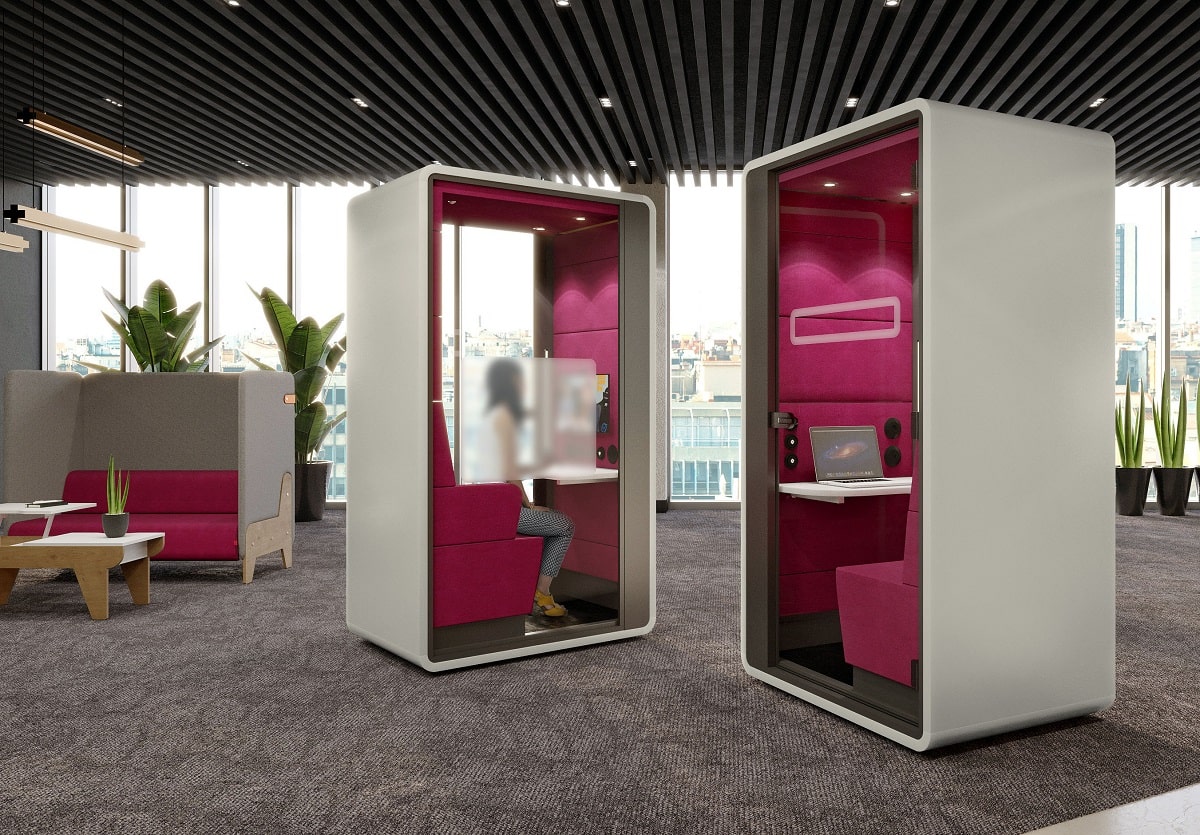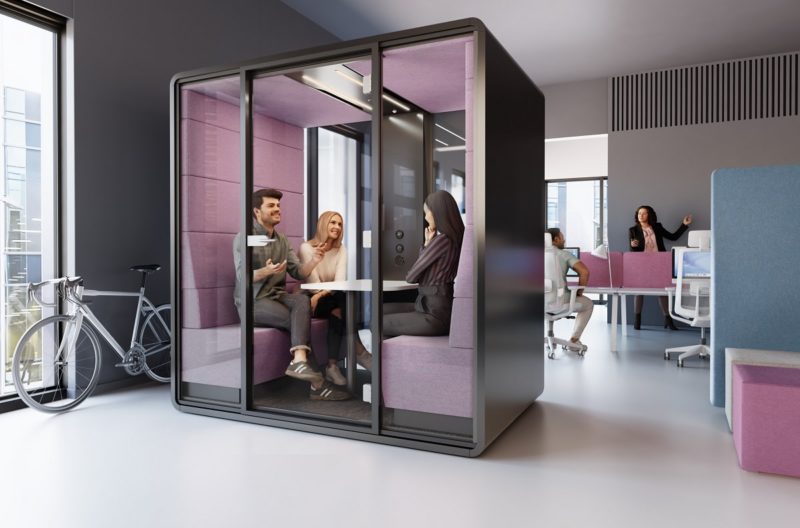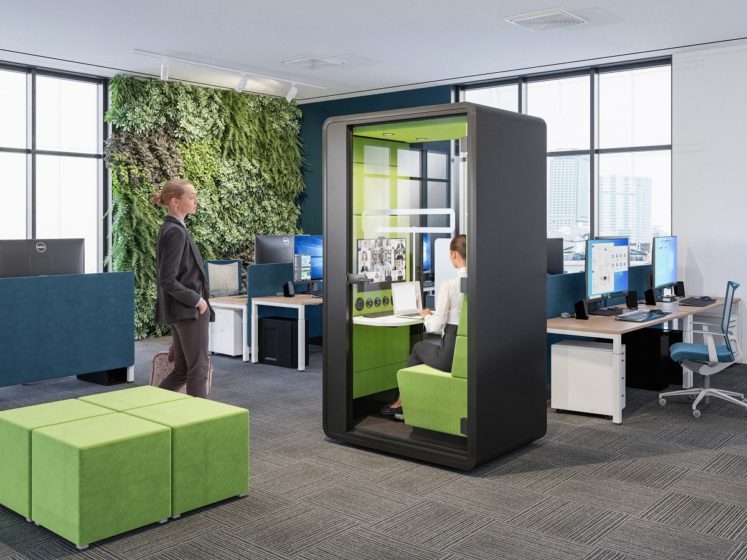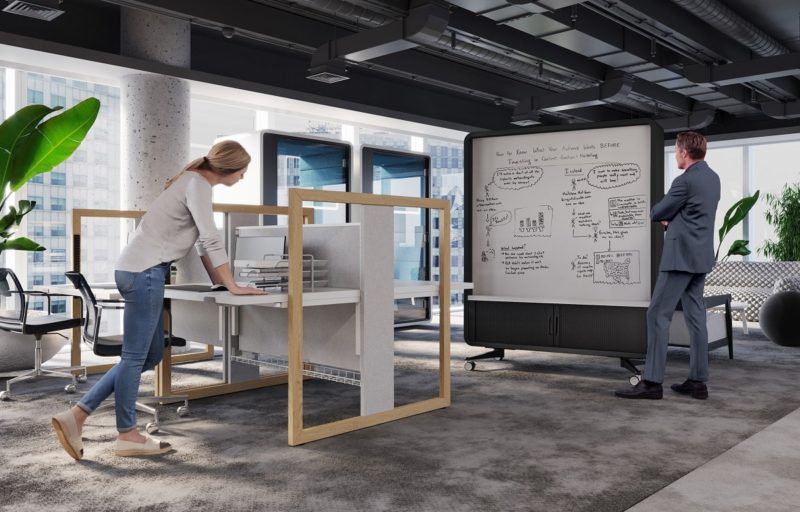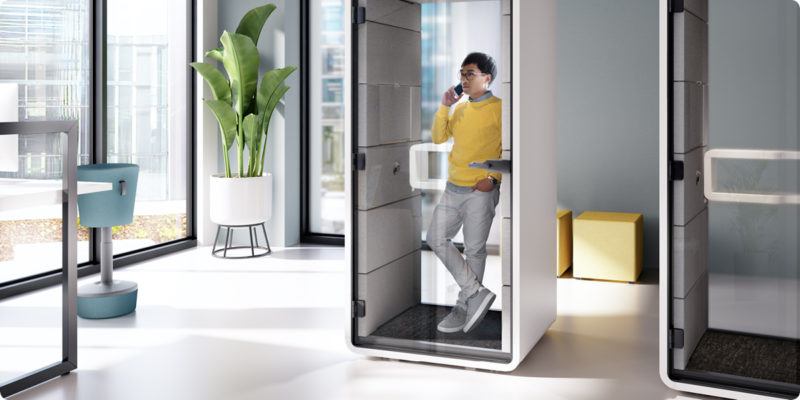Office acoustics. STC? NIC? ISO 23351-1:2020? Acoustic partition and office pod ratings explained
- Posted on: 13 February 2022
- By: Hushoffice Team
Office privacy pods, soundproof partitions, and other open-plan noise solutions often have NIC and STC ratings. And booths, specifically, are now being rated against ISO 23351-1:2020 — a new standard. What do these ratings mean? We’ve recapped office acoustics 101 to make sense of all three.
Office acoustics – key takeaways:
Sound is energy. It’s the vibration generated as an acoustic wave moves through a medium. What we hear as sound is physical pressure on the ears, measured in decibels (dB). The sound’s pitch, or tone, is measured in frequency (Hz).
The decibel scale is logarithmic, not linear. On a logarithmic scale, the power of a given sound is doubled for every 3dB increase in level. So 70dB is actually about 100 times as powerful as 50dB.
When sound hits a surface, 1 of 3 things happens: the sound is reflected, absorbed, and/or transmitted. Solid, hard surfaces reflect a lot of sound while porous, soft surfaces absorb a lot of sound.
The best way to soundproof is by using layers. High-quality materials, carefully layered, are ideal. This is why all acoustic office booths and pods in the Hushoffice catalog are built with several layers of premium materials.
Sound Transmission Class (STC) is a score indicating how much sound is stopped by a partition. The higher the STC score, the better. Noise Insulation Class (NIC) is a field measurement of the total sound insulation performance between two rooms (not just the partition). ISO 23351-1:2020 is a new standard specific to enclosing furniture like booths and pods. It measures how well the product reduces user speech level.
Pods rated class A+, A, and B guarantee the best speech privacy. B-class acoustic pods will generally be more economical and lighter than A-class pods. So they’ll cost less and be easier to move around the office.
The basics of office acoustics
What is sound? How is it measured?
What is sound?
When we talk about sound or office acoustics we are talking about energy
– explains Robert Korpacki, Product Manager, Hushoffice.
Sound is energy. It’s the vibration that’s generated as an acoustic wave moves through a medium. Oftentimes, this medium is air. But it can be anything — water, glass, steel, concrete, you name it. Like any other energy form, it likes to travel. So after a sound is made, it travels through a space, reflecting off of or absorbing into various mediums in the space as it travels.
Audible sound is pressure.
That is, what we hear is physical pressure on the ears. The lowest sound pressure audible to humans is called the hearing threshold, roughly 0-15 decibels. The highest which can be endured is called the pain threshold, roughly 140 decibels.
Sound is measured by two dimensions: decibels and frequency.
Decibels (dB) denote how loud, intense, or powerful a sound is. A loud sound has a high decibel level. Frequency (measured in hertz/Hz) denotes the sound’s tone or pitch — high-pitched or low-pitched, for instance. Higher pitched sounds have higher frequencies.
When talking about how loud a sound is, we’re referring to the sound’s decibel or pressure level. When talking about how high or how low a sound is, we’re referring to the sound’s frequency in hertz
– lends Robert Korpacki, Product Manager, Hushoffice.
A critical point of office acoustics: the decibel scale is logarithmic, not linear.
This matters because, on this logarithmic scale, the 20 integer difference between 50 dB and 70 dB isn’t nominal; it’s major. Because on a logarithmic scale, the power of sound is doubled for every 3 dB increase in level. So 70 dB is actually about 100 times as powerful as 50 dB. As shown below, those 20 integers are the difference between moderate rainfall and city traffic.
Typical noises on a decibel scale (dB):
40 dB: refrigerator
50 dB: moderate rainfall
60 dB: conversation
70 dB: city traffic
80 dB: truck
90 dB: helicopter
100 dB: trombone
120 dB: police siren
130 dB: jet engine
140 dB: fireworks
A 0 dB-40 dB sound is faint while a 50 dB-60 dB sound is moderate to quiet. 70 dB-80 dB is loud, 80 dB-90 dB is very loud, 90 dB-110 dB is extremely loud, and 140 dB is that threshold of pain.
Another critical point: dB and Hz work together, creating the sound’s perceived strength.
Scientifically, this is called the equal-loudness contour. Put simply, the principle indicates that, while higher frequency (Hz) sounds are audible at quieter volumes (dB), lower frequency sounds need to be louder to be heard. For example, if you want to hear a low voice loud and clear, it has to be projected about 50dB loud. A high-pitched voice, however, can be heard at just 3dB-5dB.
Sound is tricky because our ears are sophisticated.
Thus, office soundproofing can be tricky, too. There are many factors at play when it comes to office acoustics. Decibels are influenced by frequency. Individual factors influence how sound is perceived. And the amount of background office noise influences the effectiveness of acoustic booths and partitions.
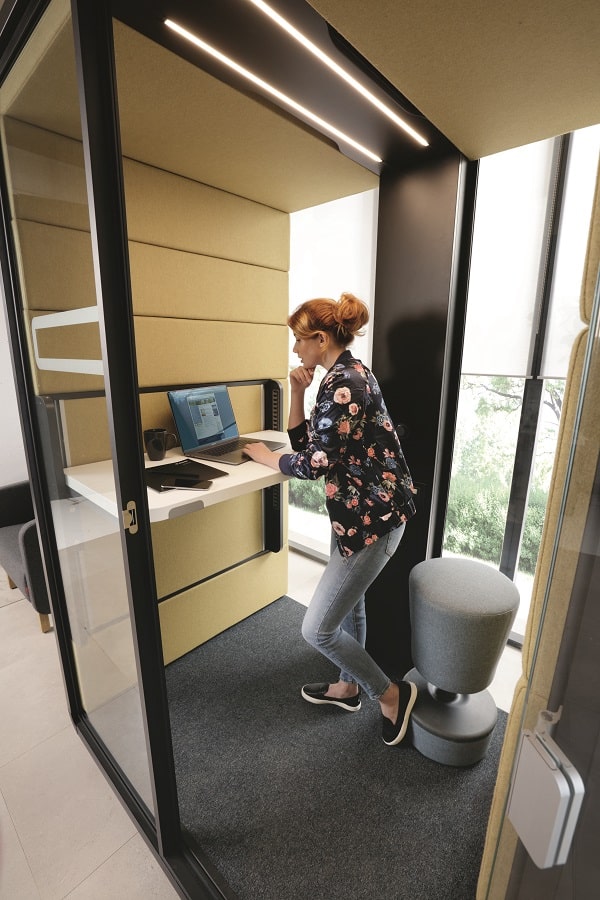
Hence quiet phone booths and other noise solutions are built and tested in a specific way.
Because sound is a bit complicated.
To get into acoustic tests, let’s review what happens to a sound when it hits a surface.
What happens to sound when it hits a surface like a partition?
1 of 3 things happens — sometimes all 3, depending on the surface’s material.
The sound is reflected off the surface at the same angle it hits (i.e., reflection or reverberation).
Some of the sound is absorbed into the medium (i.e., sound absorption or attenuation).
Some of the sound travels through the medium to the medium’s other side (i.e., sound transmission).
Whether sound is reflected, absorbed, or transmitted depends on the surface’s material.
If the medium is a very solid, hard material like concrete or glass, the majority of the sound will reflect off it. Rubber, on the other hand, will absorb a lot of the sound. Foam? Most of the sound will be absorbed, but some of it will travel through the foam to the foam’s other side.
Materials that reflect a lot of sound…
Glass, steel, wood, concrete, marble, plastic, ceramic tile, metal, granite, clay, brick, and plaster all reflect a lot of sound. Think solid, hard materials.
Materials that absorb or attenuate a lot of sound…
Foams, carpets, rugs, tapestries, curtains, and soft furniture all absorb a lot of sound. Think porous, soft materials.
Soundproofing an office is a matter of reducing sound by absorption or attenuation.
Soundproofing is also called “sound insulation” or “sound isolation.” Serious office noise solutions like soundproof partitions, screens, and baffles, acoustic dampening curtains, and sound dampening tiles are all made of materials with different degrees of sound absorption and attenuation.
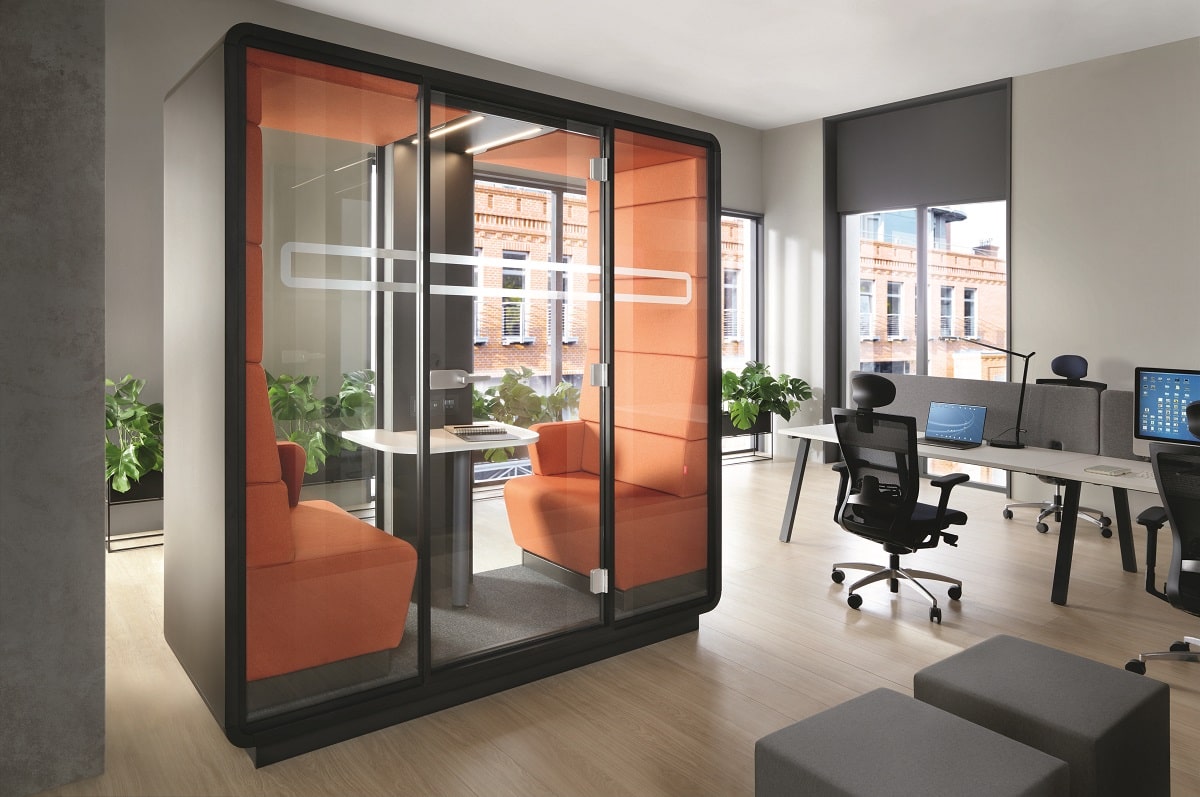
What is sound absorption?
Sound absorption is the material’s ability to transform a sound wave into unnoticeable heat energy — basically dissipating the sound. Great sound-absorbers eliminate sound reflections and reduce reverberation time.
What is sound attenuation?
Sound attenuation is the material’s ability to reduce transmission of sound through itself from one side to the other, essentially blocking sound. Instead of diffusing the sound wave, the material basically eliminates the sound inside itself.
The best way to soundproof is by using layers.
An office soundproofing solution’s noise-reduction abilities depend on its materials and the way these materials are layered. High-quality materials, carefully layered, are ideal
– adds Robert Korpacki, Product Manager, Hushoffice.
Each layer should complete a function: reflection, absorption/attenuation, or transmission. This is why acoustic meeting pods like hushMeet are built with multiple, finely stacked layers.

Office acoustics. STC, NIC, and ISO 23351-1:2020 explained.
Now for the ratings.
What is Sound Transmission Class (STC)?
STC is a score indicating how much sound is stopped by a material. Partitions, specifically (walls, screens, etc.). The higher the STC number, the better the partition is at stopping sound. In more scientific terms, STC denotes how well the partition attenuates sound, blocking transmission. It’s used where human speech is a factor.
A low STC score is a bad score.
A low score means a lot of sound gets through. A partition scored 25, for instance, is a partition through which you could more or less hear everything. Most domestic walls are rated 30-45, while luxury hotel walls that block virtually everything have an STC rating of about 60.
Denser materials have better STC ratings.
As a rule of thumb, doubling the mass generally improves sound insulation by about 5dB. Materials with air gaps (inside of them) and extra sound absorbing material also have higher STC ratings.
If the partition has an STC rating of 30, only loud speech can be heard through it.
35? Loud speech can be heard through it but not understood. 40? Loud speech is heard as only a murmur. 45? Loud speech can’t be heard at all. 50? Only very loud speech can be heard, and only faintly. 60+ is an excellent STC rating; most sound can’t be heard through a partition with an STC rating of 60 or above.
What is Noise Insulation Class (NIC)?
NIC is a field measurement of the total sound insulation performance between two rooms after construction is complete. Higher NIC values indicate higher levels of sound insulation between rooms.
How is NIC different from STC?
Though NIC is similar to STC, NIC is a field rating, while STC is a laboratory rating. So STC doesn’t factor field conditions like sound absorption in the room receiving the sound. Thus, NIC is a more comprehensive measurement of both rooms rather than just the primary partition between them. Both are helpful measurements.
What is ISO 23351-1:2020?
ISO 23351-1:2020 is a relatively new standard specific to enclosing furniture like office phone booths and other semi-enclosed furniture ensembles (conventional workstations, partially enclosed sofa groups, etc.). It measures how well the product reduces user speech level. Most phone booth manufacturers are now measuring their product’s speech level reduction against this standard.
ISO 23351-1:2020 ratings indicate the product’s speech privacy and noise-reduction.
ISO 23351-1:2020 calculates a single figure called speech level reduction (DS,A). This denotes the degree of speech privacy the product provides. A higher rating per ISO 23351-1:2020 means better speech privacy for the pod or furniture ensemble user.
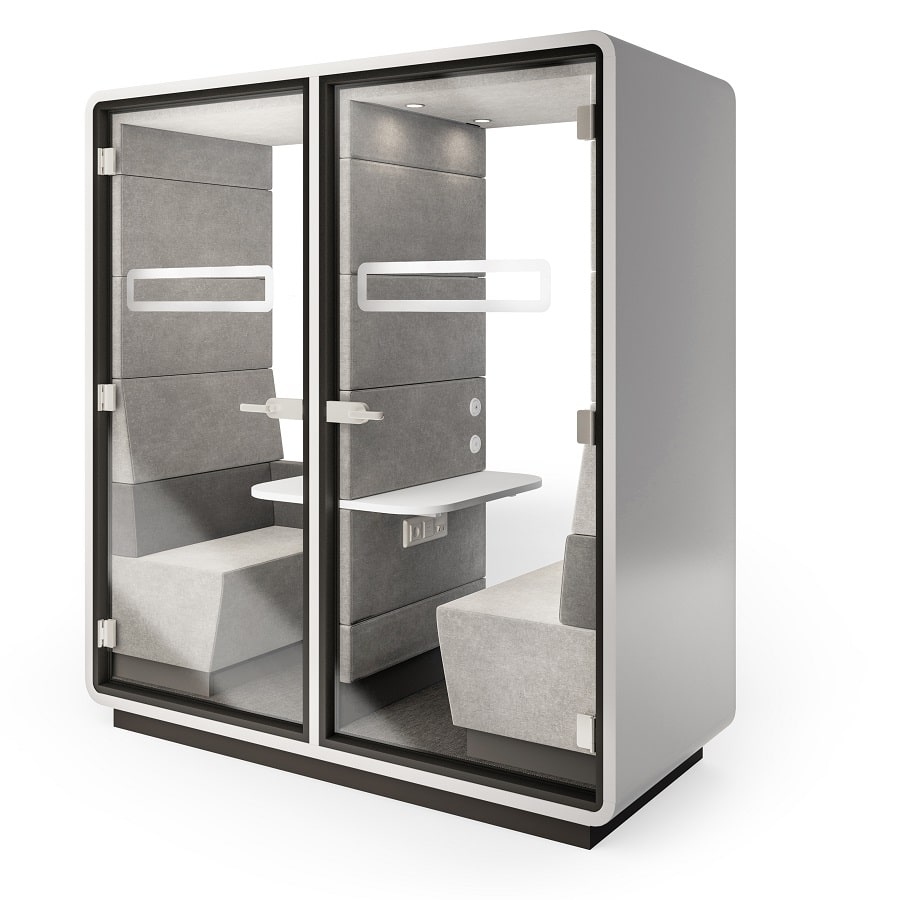
How ISO 23351-1:2020 is measured.
First, speech is measured as the control. Then, the speaker gets inside the phone booth or furniture ensemble and proceeds speaking, as a microphone outside measures how much of their speech leaks. The two measurements are then compared to calculate total speech level reduction performed by the furniture.
Office pods rated class A+, A, and B per ISO 23351-1:2020 all guarantee speech privacy.
There are many class A and class B rated work pods available on the market.
Since both A and B rated pods guarantee speech privacy, why pick one or the other?
Generally, B rated office pods will be more economical and lighter than A rated pods. So they’ll be more affordable and easier to relocate. This is why we’ve manufactured all Hush pods and booths to the class B standard. The booths are more affordable and more mobile than most class A pods. HushPhone and hushHybrid, for instance, can be relocated easily by the push of two teammates.
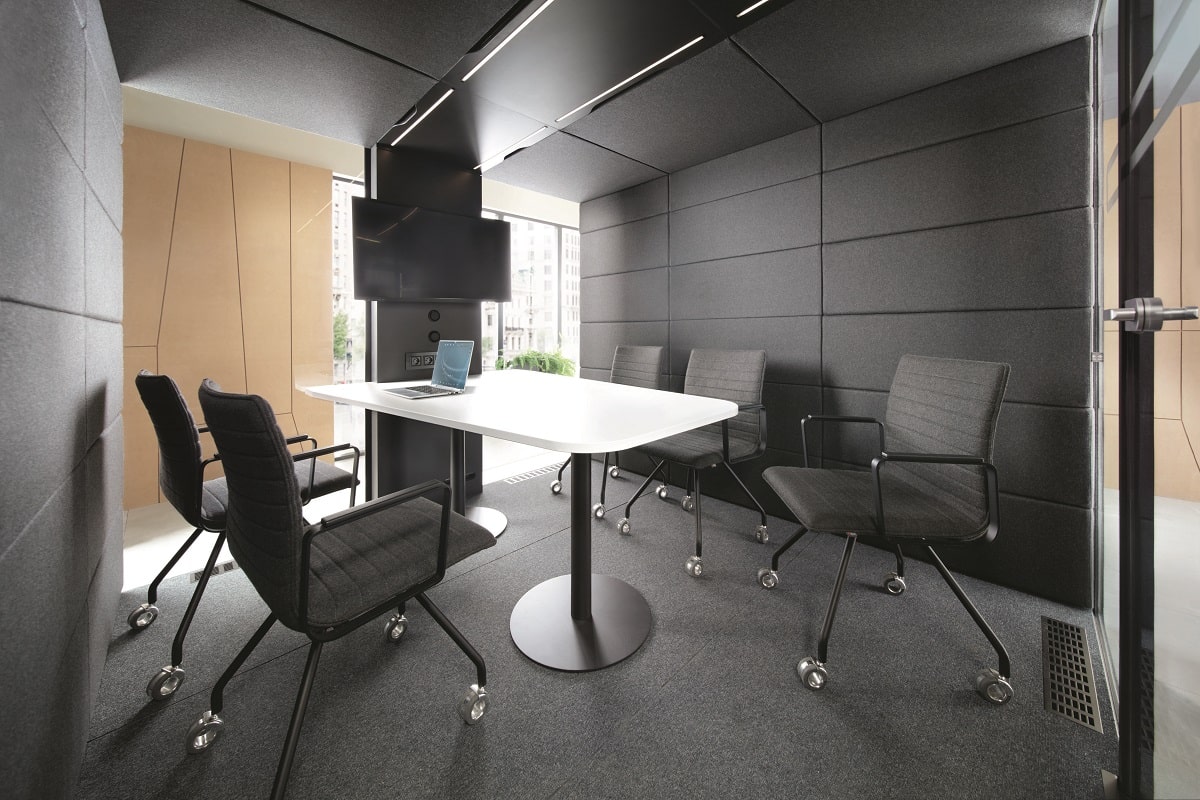
Have questions? Contact our team. We love to talk office acoustics.
Office acoustics – key takeaways:
Sound is energy. It’s the vibration generated as an acoustic wave moves through a medium. What we hear as sound is physical pressure on the ears, measured in decibels (dB). The sound’s pitch, or tone, is measured in frequency (Hz).
The decibel scale is logarithmic, not linear. On a logarithmic scale, the power of a given sound is doubled for every 3dB increase in level. So 70dB is actually about 100 times as powerful as 50dB.
When sound hits a surface, 1 of 3 things happens: the sound is reflected, absorbed, and/or transmitted. Solid, hard surfaces reflect a lot of sound while porous, soft surfaces absorb a lot of sound.
The best way to soundproof is by using layers. High-quality materials, carefully layered, are ideal. This is why all acoustic office booths and pods in the Hushoffice catalog are built with several layers of premium materials.
Sound Transmission Class (STC) is a score indicating how much sound is stopped by a partition. The higher the STC score, the better. Noise Insulation Class (NIC) is a field measurement of the total sound insulation performance between two rooms (not just the partition). ISO 23351-1:2020 is a new standard specific to enclosing furniture like booths and pods. It measures how well the product reduces user speech level.
Pods rated class A+, A, and B guarantee the best speech privacy. B-class acoustic pods will generally be more economical and lighter than A-class pods. So they’ll cost less and be easier to move around the office.
Office acoustics and pods – frequently asked questions
What is the difference between portable office pods rated class A or class B per ISO 23351-1:2020?
While both class A and class B pods (per ISO 23351-1:2020) will guarantee speech privacy, class B pods will generally be less expensive and more lightweight than class A pods.
Are telephone booths soundproof?
Office phone booths and workpods rated either class A or class B per ISO 23351-1:2020 are both soundproof. “Soundproof” meaning they guarantee speech privacy for the pod user while at the same time reducing background office noise.
What does an STC rating of 50 mean?
A partition with an STC rating of 50 is a partition through which only loud speech can be heard, and only faintly.
